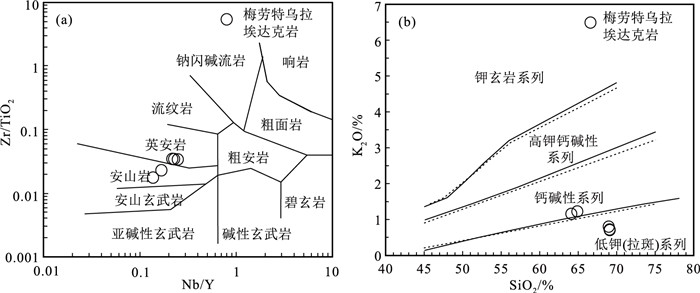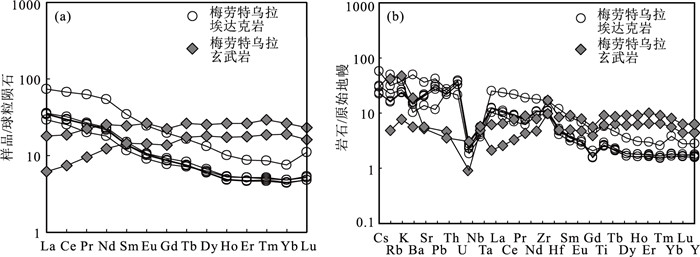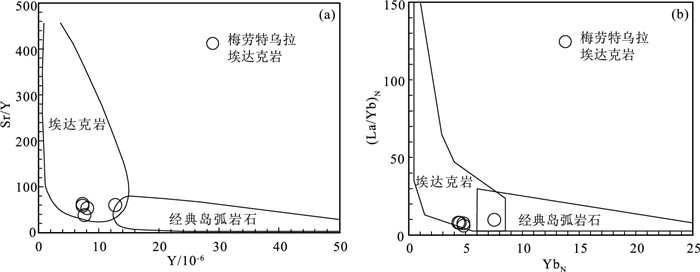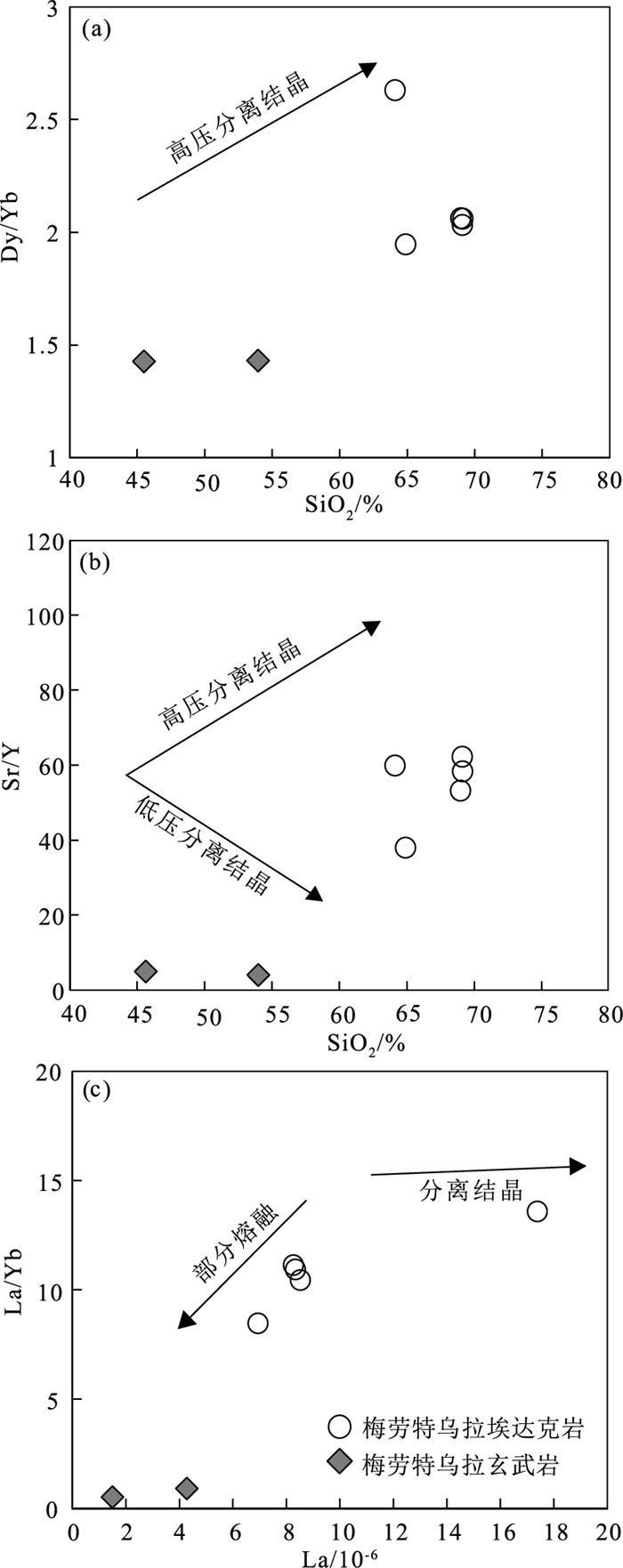The Early Permian adakite in the Meilaotewula ophiolite of Inner Mongolia and intra-oceanic subduction in eastern Palaeo-Asian Ocean
-
摘要:
贺根山缝合带东部晚石炭世梅劳特乌拉SSZ型蛇绿岩中的埃达克岩,岩性为安山岩和英安岩。LA-ICP-MS锆石U-Pb定年结果显示,埃达克岩的形成时间为294.1±2.2 Ma,时代为早二叠世。地球化学特征显示,该埃达克岩属于低钾拉斑系列和中钾钙碱性岩石,具有高硅(SiO2=64.12%~69.12%)、高铝(Al2O3=16.05%~18.59%)、富钠贫钾(Na2O=5.08%~6.80%,K2O=0.70%~1.22%,Na2O/K2O=4.50~7.26)、高Sr(291.22×10-6~762.20×10-6),低Yb(0.74×10-6~1.28×10-6)、低Y(7.33×10-6~12.74×10-6)等特征。相对富集大离子亲石元素(如K、Rb和Sr),亏损高场强元素(如Nb、Ta、Zr、Ti和P),稀土元素总量较低(40.97×10-6~108.69×10-6),贫重稀土元素,无明显的负Eu异常,为典型的埃达克岩。梅劳特乌拉埃达克岩形成于俯冲带岛弧环境,可能为俯冲洋壳部分熔融而形成的埃达克质熔体,经俯冲带上升过程中与地幔楔橄榄岩发生相互作用而形成。埃达克岩和梅劳特乌拉蛇绿岩(308 Ma)的蛇纹石化方辉橄榄岩、层状-块状辉长岩、枕状拉斑玄武岩、玻安岩、富Nb玄武岩和高镁安山岩等构成洋内初始俯冲作用形成的较丰富且完整的岩石组合序列。研究结果表明,晚石炭世—早二叠世古亚洲洋东段开启了洋内初始俯冲作用。
Abstract:This paper reports the Early Permian adakite in the Meilaotewula SSZ-type ophiolite, Inner Mongolia.The Meilaotewula adakitic rocks are mainly composed of andesite and dacite, which were emplaced into the Late Carboniferous Meilaotewula suprasubduction zone(SSZ)ophiolite and were developed along the Hegenshan suture zone.The zircon U-Pb LA-ICP-MS dating result reveals that the Meilaotewula adakite is dated at 294.1±2.2 Ma, suggesting that it was formed during Early Permian.The adakite belongs to the low-K tholeiitic and medium-K calc-alkaline series.The rocks show such geochemical characteristics as high SiO2(64.12%~69.12%)and Al2O3(16.05%~18.59%)content with rich sodium and poor potassium(Na2O=5.08%~6.80%, K2O=0.70%~1.22%, Na2O/K2O=4.50~7.26).For trace elements, they show high content of Sr(291.22×10-6~762.20×10-6)and low content of Yb(0.74×10-6~1.28×10-6)and Y(7.33×10-6~12.74×10-6).In addition, they are relatively enriched in large-ion lithophile elements such as K, Rb, and Sr and depleted in high-field-strength elements such as Nb, Ta, Zr, Ti and P. Furthermore, they have low total rare-earth element(REE)content(40.97×10-6~108.69×10-6), with low heavy rare-earth elements(HREE)without obviously negative Eu anomaly.These geochemical characteristics indicate that the Meilaotewula andesite and dacite belong to adakite.The adakite was formed in the island arc environment of subduction zone, which might have originated from partial melting of subducted oceanic crust and then interacted with mantle wedge peridotite during the rise of subduction zone.The adakite and the Meilaotewula ophiolite(308 Ma)made up one abundant and complete rock assemblage, which was formed by the initial intraoceanic subduction.Therefore, Meilaotewula ophiolite consists of serpentined augite peridotite, beded-massive gabbro, pillow basalt, boninite, Nb-enriched basalt and high-Mg andesite.The results show that the initial intraoceanic subduction occurred in Late Carboniferous to Early Permian in southeastern Palaeo-Asian Ocean.
-
Keywords:
- adakite /
- SSZ-type ophiolite /
- Early Permian /
- Palaeo-Asian Ocean /
- Inner Mongolia
-
兴蒙造山带位于西伯利亚板块和华北板块之间的中亚造山带的东南缘,由众多微陆块、岛弧、增生楔、蛇绿岩(洋壳残片)等构成,经历了复杂的构造演化历史,是目前已知发展历史长、构造岩浆活动复杂的一条巨型增生型造山带[1-7],记录了古亚洲洋俯冲、西伯利亚和华北板块最终拼合等重要的信息[8-12]。内蒙古中部地区记录了兴蒙造山带的复合造山演化过程[13]。近年围绕内蒙古中部地区早古生代以来的构造演化,尤其是古亚洲洋的闭合时间和闭合位置,存在2种不同的认识。Chen等[14]和Miao等[15]认为,碰撞缝合发生在晚二叠世—早三叠世,且兴蒙造山带的演化类似于环太平洋增生型造山带,古亚洲洋在古生代存在多次俯冲和岛弧增生过程。邵济安等[16-17]、Tang[18]和Tong等[19]认为,碰撞缝合发生在晚志留世或早中泥盆世。而从石炭纪—二叠纪开始,内蒙古中部地区在伸展构造背景下进入新的地壳演化阶段。
中亚造山带东段已识别出多条代表古海洋岩石圈碎片的古生代蛇绿岩带,然而,对蛇绿岩的形成时代没有达成共识。以往的研究大多认为贺根山蛇绿岩形成于大洋中脊[20-22],也有学者认为贺根山蛇绿岩具有俯冲带特征,如岛弧边缘盆地体系、弧后拉张洋盆等[23-25],缺乏对洋内弧的系统识别[8]。近年来,越来越多的研究表明,贺根山蛇绿岩-弧-增生带中的一些蛇绿岩是在洋内前弧环境中形成的,如迪彦庙蛇绿岩[2-3]、梅劳特乌拉蛇绿岩[4]和崇根山蛇绿岩[26]。随着对西太平洋伊豆-小笠原-马里亚纳(IBM)洋内弧的深入研究,总结出俯冲带岛弧前弧地区发育前弧玄武岩、玻安岩、富铌玄武岩(NEB)、高镁安山岩(HMA)、埃达克岩等岩石组合,记录了大洋俯冲的初始阶段[27-31]。因此,系统识别SSZ型蛇绿岩中的洋内弧初始弧是了解洋内俯冲消减过程及造山作用的有效途径。
近年来,笔者在梅劳特乌拉蛇绿岩中识别出埃达克岩,为系统研究古亚洲洋东部洋内俯冲提供了新证据。本文通过对梅劳特乌拉蛇绿岩中埃达克岩进行系统的野外特征、岩石学、地球化学和锆石U-Pb年龄研究,为古亚洲洋东段晚古生代洋内俯冲作用提供岩石学、地球化学证据和时间约束。
1. 地质背景和岩石学特征
西伯利亚板块和华北板块之间的中亚造山带是目前已知发展历史长、构造岩浆活动复杂的一条巨型增生型造山带[7](图 1-a)。兴蒙造山带位于中亚造山带的东南缘,根据近年的研究成果,将兴蒙造山带从南向北分为5个ENE—WSW向的构造带:白乃庙岛弧杂岩、温都尔庙俯冲增生杂岩、索伦缝合带、宝力道弧增生杂岩、贺根山-弧-增生杂岩带和乌里雅斯太活动大陆边缘[7](图 1-b),这些构造带向西延入蒙古南部。二连浩特-贺根山蛇绿岩带位于查干敖包-阿荣旗断裂和二连浩特-贺根山断裂之间,是兴蒙造山带蛇绿岩和俯冲岛弧型岩浆岩典型发育区。该带内断续出露二连浩特蛇绿岩、贺根山蛇绿岩、朝克山蛇绿岩、迪彦庙蛇绿岩、梅劳特乌拉蛇绿岩等NE向展布的蛇绿岩岩块。该带保留了板块闭合前古亚洲洋的信息,是了解古亚洲洋俯冲消减作用的重要地区[37]。
梅劳特乌拉埃达克岩位于内蒙古西乌旗梅劳特乌拉SSZ型蛇绿岩带中(图 1-c)。梅劳特乌拉蛇绿岩是贺根山缝合带保存较完整的SSZ型蛇绿岩之一,位于下二叠统寿山沟组复理石中,主要岩性为片理化蛇纹石化方辉橄榄岩、层状-均质块状辉长岩、枕状-块状熔岩、高镁安山岩、富铌玄武岩,上覆岩系硅质岩、硅质泥岩,各岩性之间多为断层接触[4]。埃达克岩出露于梅劳特乌拉蛇绿岩的东部,北侧与玄武岩断层接触,南侧与寿山沟组断层接触,北部被早白垩世二长花岗岩侵入(图 1-c)。安山岩和英安岩中发育强变形带和弱变形域,强变形带中形成强糜棱岩化安山岩和强糜棱岩化英安岩。
安山岩:为灰绿色-灰黑色,块状和气孔杏仁状构造(图 2-a),斑状结构(图 2-b),斑晶含量38%~40%,主要为斜长石(约35%),次为暗色矿物假象(3%~5%),粒径0.3~6.0 mm。斜长石多呈半自形板状,轻黑云母-绿泥石化,局部绿帘石化、碳酸盐化,聚片双晶较发育;暗色矿物主要呈半自形柱状、粒状,具暗化现象,被黑云母-绿泥石、硅质交代,呈假象产出,以似角闪石假象为主,少数可能为黑云母假象。基质含量60%~62%,主要由斜长石(55%~60%)、暗色矿物假象(2%~5%)组成,斜长石呈半自形板条状,粒径一般小于0.1 mm,杂乱似交织状排列,轻黑云母-绿泥石化;暗色矿物呈半自形-他形柱粒状,粒径一般小于0.03 mm,少数0.03~0.1 mm,填隙状分布于斜长石间,被黑云母-绿泥石交代,呈假象产出,可能为辉石假象。
英安岩:为浅灰色,块状构造,斑状结构,斑晶含量约20%,主要为斜长石(约15%),次为黑云母(约5%),粒径0.25~3.5 mm。斜长石呈半自形板状,具聚片双晶,较少量环带构造,轻微绢云母化、土化;黑云母呈鳞片-叶片状,局部褐铁矿化、绢云母化等,部分呈假象。基质含量约80%,由长英质构成,杂乱分布,粒度一般小于0.1 mm,呈隐晶状,少量微粒状,多被粘土、硅质不均匀交代。
2. 分析方法
梅劳特乌拉埃达克岩的主量、微量元素分析均在河北省区域地质矿产调查研究所实验室完成。主量元素分析采用Panalytical公司PW440型X荧光光谱仪(XRF)测定,分析误差低于5%;微量和稀土元素采用Thermo Fisher公司X-Se-risep型电感耦合等离子质谱仪(ICP-MS)测定,分析精度和准确度一般优于5%。
锆石分选在河北省区域地质矿产调查研究所实验室完成,采用重液浮选和电磁分离方法进行挑选,在双目镜下对分选出的锆石进行人工挑选,尽量挑选无包裹体、无裂纹、透明度高、晶形完好的锆石颗粒作为测定对象。锆石阴极发光(CL)图像分析由北京锆年领航科技有限公司的高分辨热场发射能谱阴极发光室(SEM-EDS-CL)完成。锆石原位U-Pb同位素年龄分析在中国地质调查局天津地质调查中心实验测试室完成,锆石定年所用仪器为Thermo Fisher公司Neptune型MC-ICP-MS及与之配套的New Wave UP 193激光剥蚀系统。激光剥蚀斑束直径为32 μm,激光剥蚀样品的深度为20~40 μm,锆石年龄计算采用国际上通用的标准锆石GJ-1为外标,元素含量采用美国国家标准物质局人工合成硅酸盐玻璃NIST SRM610为外标,29Si为内标元素进行校正。数据处理采用ICPMSDataCal 8.4程序[38],并采用Anderson[39]方法对测试数据进行普通铅校正,年龄计算及谐和图绘制采用Isoplot(3.0版)[40-42]完成。
3. 分析测试结果
3.1 锆石U-Pb年龄
对内蒙古梅劳特乌拉埃达克岩样品(TW3104)进行了LA-ICP-MS锆石U-Pb同位素分析。安山岩(TW3104)样品共选取17粒锆石进行测定,CL图像(图 3-a)显示,样品锆石多呈透明,半自形-自形长柱状,长宽比为1:1~3:1,锆石粒度较小,多在40~90 μm之间,内部无残留核,外部无变质边,具有火山岩岩浆锆石特征[43-45]。从表 1可以看出,17个测点的Th/U值变化较小(Th/U=0.28~0.42),均大于0.2,Th和U具有良好的正相关关系,属于岩浆锆石特征[46-47]。LA-ICP-MS锆石U-Pb定年结果(表 1)显示,17个测点的谐和度均较高,206Pb/238U年龄值为284±2~302±2 Ma,且这些数据点均落在谐和线上或其附近(图 3-b)。其年龄加权平均值为294.1±2.2 Ma(MSWD =5.0)(图 3-c),可以代表该安山岩的结晶年龄。
表 1 梅劳特乌拉埃达克岩LA-ICP-MS锆石U-Th-Pb同位素分析结果Table 1. LA-ICP-MS zircon U-Th-Pb isotopic analyses of Meilaotewula adakite点号 元素含量/10-6 Th/U 同位素比值 年龄/Ma Pb U 206Pb/238U 1σ 207Pb/235U 1σ 207Pb/206Pb 1σ 208Pb/232Th 1σ 206Pb/238U 1σ 207Pb/235U 1σ 1 11 224 0.3842 0.0480 0.0003 0.3784 0.0181 0.0572 0.0027 0.0159 0.0005 302 2 326 16 2 16 332 0.3380 0.0469 0.0003 0.3747 0.0088 0.0580 0.0013 0.0147 0.0004 295 2 323 8 3 12 251 0.2677 0.0467 0.0003 0.3541 0.0150 0.0549 0.0023 0.0141 0.0005 294 2 308 13 4 19 398 0.3672 0.0469 0.0003 0.3411 0.0077 0.0528 0.0012 0.0127 0.0004 295 2 298 7 5 17 380 0.4201 0.0450 0.0003 0.3301 0.0094 0.0531 0.0015 0.0120 0.0004 284 2 290 8 6 18 381 0.3538 0.0472 0.0003 0.3551 0.0087 0.0546 0.0013 0.0117 0.0004 297 2 309 8 7 11 230 0.2803 0.0470 0.0003 0.3540 0.0143 0.0546 0.0022 0.0119 0.0005 296 2 308 12 8 11 244 0.2960 0.0459 0.0003 0.3008 0.0144 0.0475 0.0022 0.0122 0.0004 290 2 267 13 9 21 459 0.3726 0.0464 0.0003 0.3510 0.0075 0.0549 0.0011 0.0105 0.0002 292 2 305 7 10 17 361 0.4206 0.0474 0.0003 0.3340 0.0085 0.0511 0.0013 0.0105 0.0002 298 2 293 7 11 18 395 0.3231 0.0464 0.0003 0.3334 0.0071 0.0521 0.0011 0.0100 0.0003 292 2 292 6 12 17 369 0.3188 0.0460 0.0003 0.3621 0.0109 0.0570 0.0017 0.0107 0.0003 290 2 314 9 13 21 506 0.0628 0.0456 0.0003 0.3290 0.0068 0.0523 0.0011 0.0099 0.0002 288 2 289 6 14 20 455 0.2815 0.0465 0.0003 0.3667 0.0079 0.0572 0.0012 0.0097 0.0002 293 2 317 7 15 16 357 0.3805 0.0473 0.0003 0.3413 0.0089 0.0523 0.0013 0.0089 0.0002 298 2 298 8 16 15 319 0.3675 0.0468 0.0003 0.3698 0.0105 0.0573 0.0016 0.0106 0.0002 295 2 319 9 17 17 363 0.3823 0.0473 0.0003 0.3369 0.0102 0.0516 0.0015 0.0106 0.0003 298 2 295 9 3.2 地球化学特征
本次选取5件梅劳特乌拉埃达克岩代表性样品进行主量、微量和稀土元素分析,分析结果见表 2。
表 2 梅劳特乌拉埃达克岩主量、微量和稀土元素分析结果Table 2. Major, trace elements and REE analytical results of Meilaotewula adakite岩石名称 安山岩 安山岩 英安岩 英安岩 英安岩 样品号 XT3104 XT3106 XT3106-1 XT3107 XT3107-1 SiO2 64.12 64.90 68.99 69.09 69.12 TiO2 1.08 0.45 0.34 0.34 0.34 Al2O2 18.59 17.24 16.05 16.10 16.06 Fe2O2 2.81 0.84 1.40 1.48 1.41 FeO 1.22 2.17 0.97 0.90 0.97 MnO 0.046 0.05 0.04 0.04 0.04 MgO 0.54 2.40 1.30 1.28 1.30 CaO 1.65 2.66 3.49 3.39 3.40 Na2O 6.80 5.49 5.10 5.14 5.08 K2O 1.15 1.22 0.80 0.72 0.70 P2O2 0.235 0.10 0.12 0.12 0.12 烧失量 1.61 2.12 1.18 1.19 1.24 总计 99.86 99.90 99.89 99.88 99.88 Na2O/K2O 5.91 4.50 6.41 7.17 7.24 Mg# 21.16 60.16 52.10 51.64 51.94 La 17.39 6.95 8.53 8.35 8.27 Ce 41.53 15.7 19.6 18.4 18.0 Pr 5.93 1.93 2.57 2.48 2.42 Nd 25.27 8.36 10.8 10.4 10.2 Sm 5.30 1.80 2.30 2.15 2.10 Eu 1.43 0.53 0.62 0.61 0.59 Gd 4.04 1.59 1.92 1.80 1.76 Tb 0.62 0.27 0.31 0.28 0.28 Dy 3.37 1.60 1.69 1.55 1.53 Ho 0.58 0.30 0.30 0.28 0.28 Er 1.45 0.86 0.86 0.79 0.77 Tm 0.22 0.13 0.13 0.12 0.12 Yb 1.28 0.82 0.82 0.76 0.74 Lu 0.28 0.14 0.13 0.12 0.12 Y 12.74 7.66 8.11 7.34 7.33 Sc 8.64 8.02 5.17 4.61 4.81 Ni 6.0 19.0 9.74 8.68 8.72 Rb 19.8 31.5 14.0 10.5 10.0 Cr 5.0 16.6 13.4 11.9 12.7 Co 13.0 10.2 5.86 5.84 5.77 V 67.1 47.4 32.6 31.9 32.9 Zr 199.20 101.71 117.94 120.60 118.63 Hf 5.17 2.93 3.45 3.44 3.33 Ta 0.18 0.15 0.23 0.21 0.17 Sr 762.20 291.22 431.33 456.47 427.22 Ba 344.7 71.2 107 110 101 Nb 1.77 1.30 1.98 1.66 1.61 Cs 1.84 0.96 0.99 0.72 0.75 Ga 17.39 14.4 16.2 16.4 16.1 Pb 7.7 2.15 5.86 5.52 5.04 Th 2.32 2.02 2.04 1.84 1.84 U 0.82 0.44 0.77 0.69 0.68 ∑REE 108.69 40.97 50.60 48.07 47.16 LREE/HREE 8.18 6.19 7.23 7.43 7.41 (La/Yb)N 9.73 6.07 7.48 7.84 7.98 δEu 0.91 0.93 0.88 0.92 0.91 注:主量元素含量单位为%,微量和稀土元素含量单位为10-6 从表 2可以看出,梅劳特乌拉埃达克岩样品富硅(SiO2含量为64.12%~69.12%,平均值为67.24%,均大于56%),高铝(Al2O3含量为16.05%~18.59%,大于15%),富钠、贫钾,Na2O含量为5.08%~6.80%, K2O含量为0.70%~1.22%,Na2O/K2O值为4.50~7.26,均大于1%;MgO含量为0.54%~2.40%,均小于3%,Mg#值平均47.40,较高;贫TiO2(0.34%~1.08%)和P2O5(0.10%~1.24%)。在不活动性元素Nb/Y-Zr/TiO2分类图解(图 4-a)上,样品点落入安山岩和英安岩区域,其A/CNK值在1.03~1.20之间,A/NK值为1.50~1.76,属于过铝质岩石。
在SiO2-K2O分类图解(图 4-b)中,有3个样品点落在低钾拉斑系列,其余2个样品点分布在低钾(拉斑)系列和中钾钙碱性系列的边界上。梅劳特乌拉埃达克岩样品显示出从低钾(拉斑)系列到中钾钙碱性系列演化的趋势,类似于典型埃达克岩的地球化学特征[50-51]。
梅劳特乌拉埃达克岩的稀土元素总量(∑REE)明显较低,为40.97×10-6~108.69×10-6。稀土元素球粒陨石标准化配分曲线图(图 5-a)显示,富集轻稀土元素(LREE),贫重稀土元素(HREE),轻、重稀土元素分异明显((La/Yb)N=6.07~9.73),配分曲线为右倾型;无明显Eu异常(δEu=0.88~0.91);Yb含量为0.74×10-6~1.28×10-6,均小于1.9×10-6;Y含量为7.33×10-6~12.74×10-6,均小于18×10-6;Sr含量为291.22×10-6~762.20×10-6,接近或大于400×10-6,其地球化学特征符合典型埃达克岩的地球化学特征[54-56]。样品相对富集大离子亲石元素(LILE)Rb、K、Sr和U,而相对亏损高场强元素(HFSE)Nb、Ta和Ti(图 5-a),具典型的俯冲相关岩浆岩的特征[57]。
在图 5-b中,梅劳特乌拉埃达克岩的微量元素蛛网图与梅劳特乌拉蛇绿岩中玄武岩的微量元素一致,具有LILE(K、Rb和Sr)富集和HFSE(Nb、Ta和Ti)亏损的特征,与大洋俯冲带有关的岛弧构造环境一致[56-57]。
4. 讨论
4.1 岩石特征、成因和构造环境
埃达克岩(adakite)是一套中酸性的火成岩,以SiO2≥56%,Al2O3≥15%,MgO<3%, Sr含量高(Sr>400×10-6)、贫Y和Yb(Y≤18×10-6,Yb≤1.9×10-6),轻稀土元素富集,无Eu异常(或轻微负Eu异常)为特征[54, 56]。梅劳特乌拉蛇绿岩中埃达克岩样品SiO2含量为64.12%~69.12%,MgO为0.54%~2.40%, Al2O3为16.05%~18.59%,Na2O为5.08%~6.80%,Na2O/K2O值为4.50~7.26,Sr为291.22×10-6~762.20×10-6,Y为7.33×10-6~12.74×10-6,Yb为0.74×10-6~1.28×10-6,稀土元素总量较低,轻稀土元素富集、重稀土元素亏损,负Eu异常不明显(表 2;图 5),符合典型埃达克岩的地球化学特征。在Y-Sr/Y(图 6-a)和YbN-(La/Yb)N(图 6-b)图解中,样品点均落入埃达克岩区域。
近年来,埃达克岩的研究受到国内外学者的广泛关注,关于埃达克岩的成因目前主要有以下4种认识:①俯冲洋壳的部分熔融[56, 58];②加厚地壳的下地壳部分熔融[59-63];③拆沉下地壳部分熔融[64-65];④地幔岩浆的同化混染和分离结晶(AFC)作用[66-68]。
加厚地壳的下地壳部分熔融或拆沉下地壳部分熔融形成的埃达克岩通常有相对高的K2O含量、低的MgO含量和Mg#值(<45)[69-70]。然而,梅劳特乌拉埃达克岩的主量元素显示,其为低钾(拉斑)系列岩石(图 4-b),明显富Na2O(5.08%~6.80%)、贫K2O(0.70%~1.22%),Mg#值较高(47.40)。因此,梅劳特乌拉埃达克岩不是由加厚地壳或拆沉的下地壳部分熔融形成的。
基性岩浆一般具有高的MgO含量和低的Sr/Y(2.8~53.5,平均22.8)值,若基性岩浆通过分离结晶演化成富硅的埃达克质岩浆,则Sr/Y值一般随着Mg#值的降低而升高。角闪石和单斜辉石在低压条件下分异稀土元素、Y等微量元素[71],而且通常优先富集中稀土元素,其次是重稀土元素,亏损轻稀土元素[72]。角闪石和单斜辉石矿物分离结晶会使残余熔体(Dy/Yb) N和(La/Yb) N之间具负相关关系,斜长石的分离结晶会导致Sr和Eu具有明显的负异常。而石榴子石和角闪石的高压分馏结晶作用会使Sr/Y和Dy/Yb值随SiO2含量增加而增加[68, 73]。梅劳特乌拉埃达克岩具有轻微负Eu异常(δEu=0.88~0.93),(Dy/Yb) N和(La/Yb) N之间存在较好的正相关关系(图 7),Sr/Y和Dy/Yb值也不具有随SiO2含量增加而增加的特征(图 8-a、b)。因此,不具备玄武质岩浆的同化混染和分离结晶成因特征。此外,梅劳特乌拉埃达克岩显示出与部分熔融一致的趋势(图 8-c),故梅劳特乌拉埃达克岩显示俯冲洋壳部分熔融成因特征。
梅劳特乌拉埃达克岩高铝、高钠(Na2O为5.08%~6.80%,Na2O/K2O值为4.50~7.26)、高Sr,贫Y、Yb,相对富集大离子亲石元素K、Rb、和Sr,亏损高场强元素Nb、Ta、Zr、Ti、P等(表 2;图 5),稀土元素总量较低,贫重稀土元素,轻、重稀土元素分馏明显,δEu=0.88~0.93,具轻微负Eu异常,与中亚造山带东段内蒙古地区俯冲带岛弧型埃达克岩的地球化学特征较一致[75-78],属于O型埃达克岩。富钠、贫钾和较高的Na2O/K2O值是俯冲洋壳玄武岩的特征。与玄武岩相比,贫重稀土元素和Y、高Sr,表明梅劳特乌拉埃达克岩是俯冲洋壳在中高压条件下部分熔融形成的。此外,与典型的埃达克岩相比,梅劳特乌拉埃达克岩中硅和镁的含量更高(表 2)。一般认为,玄武岩部分熔融形成的熔体Mg#≤45,而大洋俯冲板片熔融作用形成的初始埃达克质熔体在上升至地表过程中需穿越地幔楔,其必然与地幔橄榄岩发生物质交换和相互作用,这种相互作用使残余熔体的MgO含量和Mg#值增高,Mg#值增大的程度指示熔体与地幔楔相互作用的强度[79-80]。
与MORB和前弧玄武岩相比,梅劳特乌拉埃达克岩具有较高的Th含量(1.84×10-6~2.32×10-6)和较高的Th/La(0.13~0.29)、Th/Sm(0.44~1.12)、Th/Yb(1.81~2.49)、Th/Ce(0.06~0.13)值(表 2)。Th元素通常富集于沉积物中,反映了岩浆源区沉积物组分的加入(图 9)。因此,梅劳特乌拉埃达克岩可能是俯冲洋壳加沉积物部分熔融形成的埃达克质熔体,经俯冲带上升至地表过程中与地幔楔橄榄岩发生相互作用而形成。
![]() 图 9 梅劳特乌拉埃达克岩Th/Sm-Th/Yb图解[81]Figure 9. Th/Sm-Th/Yb diagram of the Meilaotewula adakite
图 9 梅劳特乌拉埃达克岩Th/Sm-Th/Yb图解[81]Figure 9. Th/Sm-Th/Yb diagram of the Meilaotewula adakite关于大洋俯冲带岛弧型埃达克岩形成的构造环境,近年来国际深海钻探在伊豆-小笠原-马里亚纳(IBM)的研究揭示,该类岩石是洋内弧前弧岩石组合的重要组成部分,与前弧玄武岩(FAB)、玻安岩、高镁安山岩等构成洋内弧前弧玄武岩家族[82-83]。梅劳特乌拉埃达克岩与梅劳特乌拉SSZ型蛇绿岩中的前弧玄武岩、玻安岩、高镁安山岩等共同组成古亚洲洋东段洋内弧前弧岩石组合,与IBM一致。
在(Yb+Ta)-Rb构造判别图解(图 10-a)中,梅劳特乌拉埃达克岩样品点落入火山岛弧区。在不相容元素对Nb/Yb-Th/Yb的相关图解(图 10-b)上,前弧拉斑玄武岩落在大洋岛弧区域和弱俯冲区域,而埃达克岩落入大洋岛弧边界及其附近区域。在Hf/3-Th-Nb/16图解(图 10-c)中,前弧拉斑玄武岩样品点落在岛弧拉斑玄武岩(IAT)范围或岛弧拉斑玄武岩和大洋中脊玄武岩之间的边界,类似于IBM的前弧玄武岩[28],而大多数埃达克岩落在钙碱性弧玄武岩区(CAB),Th的增加显示出从早期的枕状前弧拉斑玄武岩到晚期埃达克岩的演化趋势,表明俯冲带Th富集程度增加,类似于IBM前弧的演化[83]。Th-La/Yb判别图解可用于区分原始大洋弧、演化的大洋弧、大陆边缘弧和安第斯岛弧[87-88],在Th-La/Yb判别图解(图 10-d)中,梅劳特乌拉蛇绿岩中前弧拉斑玄武岩样品点落入原始大洋弧区,埃达克岩5个样品点均落入演化的大洋弧区域内部或边缘,表现出明显的洋内弧前弧初始弧的地球化学演化特征,可能进一步反映梅劳特乌拉埃达克岩形成于前弧拉斑玄武岩岩浆递进演变并稍晚喷出的喷出岩[87]。
![]() 图 10 梅劳特乌拉埃达克岩(Yb+Ta)-Rb[84](a)、Nb/Yb-Th/Yb[85](b)、Hf/3-Th-Nb/16[86](c)和Th-La/Yb(d)构造判别图解[87](梅劳特乌拉玄武岩数据据参考文献[16],岩性符号同图 8)syn-COLG—同碰撞花岗岩;VAG—火山弧花岗岩;WPG—板内花岗岩;ORG—洋脊花岗岩IAT—岛弧拉斑玄武岩;CAB—岛弧钙碱性玄武岩;WPT—板内拉斑玄武岩;WPAB—板内碱性玄武岩Figure 10. (Yb+Ta)-Rb(a), Nb/Yb-Th/Yb(b), Hf-Th-Nb(c)and Th-La/Yb(d) diagrams of the Meilaotewula adakite
图 10 梅劳特乌拉埃达克岩(Yb+Ta)-Rb[84](a)、Nb/Yb-Th/Yb[85](b)、Hf/3-Th-Nb/16[86](c)和Th-La/Yb(d)构造判别图解[87](梅劳特乌拉玄武岩数据据参考文献[16],岩性符号同图 8)syn-COLG—同碰撞花岗岩;VAG—火山弧花岗岩;WPG—板内花岗岩;ORG—洋脊花岗岩IAT—岛弧拉斑玄武岩;CAB—岛弧钙碱性玄武岩;WPT—板内拉斑玄武岩;WPAB—板内碱性玄武岩Figure 10. (Yb+Ta)-Rb(a), Nb/Yb-Th/Yb(b), Hf-Th-Nb(c)and Th-La/Yb(d) diagrams of the Meilaotewula adakite综上所述,梅劳特乌拉蛇绿岩中的埃达克岩具有洋内弧的地球化学特征,可能形成于洋内弧环境,应属于大洋俯冲带岩浆作用和洋内弧型岩浆岩,可与典型洋内弧型岩浆岩对比[27, 86-87]。因此,梅劳特乌拉埃达克岩可能形成于古亚洲洋东段洋内弧的前弧环境或洋内俯冲的初始阶段。
4.2 形成时代和地质意义
梅劳特乌拉埃达克岩的LA-ICP-MS锆石U-Pb年龄为294.1±2.2 Ma,与内蒙古中部二叠纪岛弧型岩浆岩的形成年龄一致[89-91]。与该地区下二叠统寿山沟组的半深海-深海复理石对应,表明古亚洲洋梅劳特乌拉小洋盆在早二叠世尚未闭合,而是处于洋内俯冲阶段[89-91]。梅劳特乌拉埃达克岩的结晶年龄为294.1±2.2Ma,与梅劳特乌拉蛇绿岩中辉长岩的年龄(308.5 Ma)[16]、埃达克质花岗闪长岩(292.3 Ma)一致[19],进一步揭示古亚洲洋东段晚石炭世洋内初始俯冲作用形成了梅劳特乌拉SSZ型蛇绿岩,而早期的晚石炭世辉长岩、前弧玄武岩到晚期的高镁安山岩、埃达克岩(294.1±2.2 Ma)和花岗闪长岩之间具有一定的岩浆演化关系[92-97]。梅劳特乌拉埃达克岩的结晶年龄也与内蒙古中东部地区中二叠统哲斯组泥岩中放射虫的时代一致[98],进一步表明,在早二叠世之前,古亚洲洋东段并未闭合,而是正在经历洋内俯冲。因此,早二叠世记录了古亚洲洋东部梅劳特乌拉洋内弧的初始俯冲阶段。
测年结果显示,早二叠世由俯冲洋壳部分熔融形成的埃达克质岩浆,同时发生了侵入作用(形成花岗闪长岩)和喷出作用(形成安山岩和英安岩)。因此,梅劳特乌拉SSZ型蛇绿岩、玻安岩、高镁安山岩和与其共存的埃达克岩,为研究古亚洲洋东段的洋内初始俯冲详细过程提供了较丰富的岩石学证据和时间约束。
5. 结论
(1) 内蒙古梅劳特乌拉SSZ型蛇绿岩中安山岩形成于早二叠世,年龄为294.1±2.2 Ma,其地球化学特征符合埃达克岩的地球化学特征,应属于埃达克岩。
(2) 梅劳特乌拉埃达克岩可能是俯冲洋壳部分熔融形成的埃达克质熔体,经俯冲带上升过程中与地幔楔橄榄岩发生相互作用而形成。
(3) 梅劳特乌拉埃达克岩和共存的SSZ型蛇绿岩、高镁安山岩、埃达克质花岗闪长岩等,组成古亚洲洋东段的晚石炭世—早二叠世初始洋内俯冲岩石组合,记录了古亚洲洋晚古生代洋内俯冲、洋陆转换过程的岩石学、地球化学和年代学信息。
致谢: 在野外调查和写作过程中得到中国地质大学(北京)张招崇、袁国礼、王根厚教授等的指导和帮助,河北地质大学郭雷亮、王帅、汪轩辰等也做了大量工作,审稿专家提出了宝贵的修改意见,在此一并表示衷心的感谢。 -
图 9 梅劳特乌拉埃达克岩Th/Sm-Th/Yb图解[81]
Figure 9. Th/Sm-Th/Yb diagram of the Meilaotewula adakite
图 10 梅劳特乌拉埃达克岩(Yb+Ta)-Rb[84](a)、Nb/Yb-Th/Yb[85](b)、Hf/3-Th-Nb/16[86](c)和Th-La/Yb(d)构造判别图解[87](梅劳特乌拉玄武岩数据据参考文献[16],岩性符号同图 8)
syn-COLG—同碰撞花岗岩;VAG—火山弧花岗岩;WPG—板内花岗岩;ORG—洋脊花岗岩IAT—岛弧拉斑玄武岩;CAB—岛弧钙碱性玄武岩;WPT—板内拉斑玄武岩;WPAB—板内碱性玄武岩
Figure 10. (Yb+Ta)-Rb(a), Nb/Yb-Th/Yb(b), Hf-Th-Nb(c)and Th-La/Yb(d) diagrams of the Meilaotewula adakite
表 1 梅劳特乌拉埃达克岩LA-ICP-MS锆石U-Th-Pb同位素分析结果
Table 1 LA-ICP-MS zircon U-Th-Pb isotopic analyses of Meilaotewula adakite
点号 元素含量/10-6 Th/U 同位素比值 年龄/Ma Pb U 206Pb/238U 1σ 207Pb/235U 1σ 207Pb/206Pb 1σ 208Pb/232Th 1σ 206Pb/238U 1σ 207Pb/235U 1σ 1 11 224 0.3842 0.0480 0.0003 0.3784 0.0181 0.0572 0.0027 0.0159 0.0005 302 2 326 16 2 16 332 0.3380 0.0469 0.0003 0.3747 0.0088 0.0580 0.0013 0.0147 0.0004 295 2 323 8 3 12 251 0.2677 0.0467 0.0003 0.3541 0.0150 0.0549 0.0023 0.0141 0.0005 294 2 308 13 4 19 398 0.3672 0.0469 0.0003 0.3411 0.0077 0.0528 0.0012 0.0127 0.0004 295 2 298 7 5 17 380 0.4201 0.0450 0.0003 0.3301 0.0094 0.0531 0.0015 0.0120 0.0004 284 2 290 8 6 18 381 0.3538 0.0472 0.0003 0.3551 0.0087 0.0546 0.0013 0.0117 0.0004 297 2 309 8 7 11 230 0.2803 0.0470 0.0003 0.3540 0.0143 0.0546 0.0022 0.0119 0.0005 296 2 308 12 8 11 244 0.2960 0.0459 0.0003 0.3008 0.0144 0.0475 0.0022 0.0122 0.0004 290 2 267 13 9 21 459 0.3726 0.0464 0.0003 0.3510 0.0075 0.0549 0.0011 0.0105 0.0002 292 2 305 7 10 17 361 0.4206 0.0474 0.0003 0.3340 0.0085 0.0511 0.0013 0.0105 0.0002 298 2 293 7 11 18 395 0.3231 0.0464 0.0003 0.3334 0.0071 0.0521 0.0011 0.0100 0.0003 292 2 292 6 12 17 369 0.3188 0.0460 0.0003 0.3621 0.0109 0.0570 0.0017 0.0107 0.0003 290 2 314 9 13 21 506 0.0628 0.0456 0.0003 0.3290 0.0068 0.0523 0.0011 0.0099 0.0002 288 2 289 6 14 20 455 0.2815 0.0465 0.0003 0.3667 0.0079 0.0572 0.0012 0.0097 0.0002 293 2 317 7 15 16 357 0.3805 0.0473 0.0003 0.3413 0.0089 0.0523 0.0013 0.0089 0.0002 298 2 298 8 16 15 319 0.3675 0.0468 0.0003 0.3698 0.0105 0.0573 0.0016 0.0106 0.0002 295 2 319 9 17 17 363 0.3823 0.0473 0.0003 0.3369 0.0102 0.0516 0.0015 0.0106 0.0003 298 2 295 9 表 2 梅劳特乌拉埃达克岩主量、微量和稀土元素分析结果
Table 2 Major, trace elements and REE analytical results of Meilaotewula adakite
岩石名称 安山岩 安山岩 英安岩 英安岩 英安岩 样品号 XT3104 XT3106 XT3106-1 XT3107 XT3107-1 SiO2 64.12 64.90 68.99 69.09 69.12 TiO2 1.08 0.45 0.34 0.34 0.34 Al2O2 18.59 17.24 16.05 16.10 16.06 Fe2O2 2.81 0.84 1.40 1.48 1.41 FeO 1.22 2.17 0.97 0.90 0.97 MnO 0.046 0.05 0.04 0.04 0.04 MgO 0.54 2.40 1.30 1.28 1.30 CaO 1.65 2.66 3.49 3.39 3.40 Na2O 6.80 5.49 5.10 5.14 5.08 K2O 1.15 1.22 0.80 0.72 0.70 P2O2 0.235 0.10 0.12 0.12 0.12 烧失量 1.61 2.12 1.18 1.19 1.24 总计 99.86 99.90 99.89 99.88 99.88 Na2O/K2O 5.91 4.50 6.41 7.17 7.24 Mg# 21.16 60.16 52.10 51.64 51.94 La 17.39 6.95 8.53 8.35 8.27 Ce 41.53 15.7 19.6 18.4 18.0 Pr 5.93 1.93 2.57 2.48 2.42 Nd 25.27 8.36 10.8 10.4 10.2 Sm 5.30 1.80 2.30 2.15 2.10 Eu 1.43 0.53 0.62 0.61 0.59 Gd 4.04 1.59 1.92 1.80 1.76 Tb 0.62 0.27 0.31 0.28 0.28 Dy 3.37 1.60 1.69 1.55 1.53 Ho 0.58 0.30 0.30 0.28 0.28 Er 1.45 0.86 0.86 0.79 0.77 Tm 0.22 0.13 0.13 0.12 0.12 Yb 1.28 0.82 0.82 0.76 0.74 Lu 0.28 0.14 0.13 0.12 0.12 Y 12.74 7.66 8.11 7.34 7.33 Sc 8.64 8.02 5.17 4.61 4.81 Ni 6.0 19.0 9.74 8.68 8.72 Rb 19.8 31.5 14.0 10.5 10.0 Cr 5.0 16.6 13.4 11.9 12.7 Co 13.0 10.2 5.86 5.84 5.77 V 67.1 47.4 32.6 31.9 32.9 Zr 199.20 101.71 117.94 120.60 118.63 Hf 5.17 2.93 3.45 3.44 3.33 Ta 0.18 0.15 0.23 0.21 0.17 Sr 762.20 291.22 431.33 456.47 427.22 Ba 344.7 71.2 107 110 101 Nb 1.77 1.30 1.98 1.66 1.61 Cs 1.84 0.96 0.99 0.72 0.75 Ga 17.39 14.4 16.2 16.4 16.1 Pb 7.7 2.15 5.86 5.52 5.04 Th 2.32 2.02 2.04 1.84 1.84 U 0.82 0.44 0.77 0.69 0.68 ∑REE 108.69 40.97 50.60 48.07 47.16 LREE/HREE 8.18 6.19 7.23 7.43 7.41 (La/Yb)N 9.73 6.07 7.48 7.84 7.98 δEu 0.91 0.93 0.88 0.92 0.91 注:主量元素含量单位为%,微量和稀土元素含量单位为10-6 -
Ruzhentsev S V, Mossakovskiy A A.Geodynamics and tectonic evolution of the central Asian paleozoic structures as the result of the interaction between the pacific and Indo-Atlantic segments of the Earth[J].Geotectonics, 1996, 29(4):294-311 http://www.researchgate.net/publication/285858329_Geodynamics_and_tectonic_evolution_of_the_Central_Asian_Paleozoic_structures_as_the_result_of_the_interaction_between_the_Pacific_and_Indo-Atlantic_segments_of_the_Earth
李英杰, 王金芳, 李红阳, 等.内蒙古西乌珠穆沁旗迪彦庙蛇绿岩的识别[J].岩石学报, 2012, 28(4):1282-1290. http://www.wanfangdata.com.cn/details/detail.do?_type=perio&id=ysxb98201204024 李英杰, 王金芳, 李红阳, 等.内蒙西乌旗白音布拉格蛇绿岩地球化学特征[J].岩石学报, 2013, 29(8):2719-2730. http://www.wanfangdata.com.cn/details/detail.do?_type=perio&id=ysxb98201308009 李英杰, 王金芳, 李红阳, 等.内蒙古西乌旗梅劳特乌拉蛇绿岩的识别[J].岩石学报, 2015, 31(5):1461-1470. http://www.wanfangdata.com.cn/details/detail.do?_type=perio&id=ysxb98201505020 李英杰, 王金芳, 王根厚, 等.内蒙古迪彦庙蛇绿岩带达哈特前弧玄武岩的发现及其地质意义[J].岩石学报, 2018, 24(2):2719-2730. http://www.wanfangdata.com.cn/details/detail.do?_type=perio&id=ysxb98201802019 Kovalenko V I, Yarmolyuk V V, Kovach V P, et al.Isotope provinces, mechanisms of generation and sources of the continental crust in the Central Asian mobile belt:Geological and isotopic evidence[J].Journal of Asian Earth Sciences, 2004, 23(5):605-627. doi: 10.1016/S1367-9120(03)00130-5
Xiao W J, Windley B F, Huang B C, et al.End-Permian to mid-Triassic ermination of the accretionary processes of the southern Altaids:Implications for the geodynamic evolution, Phanerozoic continental growth, and metallogeny of Central Asia[J].Int.J.Earth Sci.Geol.Rundsch, 2009, 98:1189-1217. doi: 10.1007/s00531-008-0407-z
Li Y J, Wang G H, Santosh M, et al.Subduction initiation of the SE Paleo-Asian Ocean:Evidence from a well preserved intra-oceanic forearc ophiolite fragment in central Inner Mongolia[J].Earth and Planetary Science Letters, 2020.535:116087. doi: 10.1016/j.epsl.2020.116087
Li Y J, Wang J F, Xin H T, et al.Subduction initiation in the southeastern Palaeo-Asian Ocean:Constraints from early Permian adakites in suprasubduction zone ophiolites, central Inner Mongolia, North China[J].Geological Journal, 2020, 55:2044-2061. doi: 10.1002/gj.3696
王荃, 刘雪亚, 李锦轶.中国华夏与安加拉古陆间的板块构造[M].北京:北京大学出版社, 1991:151. 唐克东.中朝板块北侧褶皱带构造演化及成矿规律[M].北京:北京大学出版社, 1992:305. Li J Y.Permian geodynamic setting of Northeast China and adjacent regions:Closure of the Paleo-Asian Ocean and subduction of the Paleo-Pacific plate[J].Journal of Asian Earth Sciences, 2006, 26(3/4):207-224. https://www.sciencedirect.com/science/article/pii/S1367912005001598
张晋瑞, 魏春景, 初航.兴蒙造山带构造演化的新模式:来自内蒙古中部四期不同类型变质作用的证据[J].岩石学报, 2018, 34(10):2857-2872. http://www.cnki.com.cn/Article/CJFDTotal-YSXB201810004.htm Chen B, Jahn B M, Wilde S A, et al.Two contrasting Paleozoic magmatic belts in northern Inner Mongolia, China:Petrogenesis and tectonic implications[J].Tectonophysics, 2000, 328(1/2):157-182. http://www.sciencedirect.com/science/article/pii/S0040195100001827
Miao L C, Fan W M, Liu D Y, et al.Geochronology and geochemistry of the Hegenshan ophiolitic complex:Implications for late-stage tectonic evolution of the Inner Mongolia-Daxinganling Orogenic Belt, China[J].Journal of Asian Earth Science, 2008, 32(5/6):348-370. http://www.sciencedirect.com/science/article/pii/S1367912007002222
邵济安.中朝板块北缘中段地壳演化[M].北京:北京大学出版社, 1991:1-135. 邵济安, 唐克东, 何国琦.内蒙古早二叠世构造古地理的再造[J].岩石学报, 2014, 30(7):1858-1866. http://www.wanfangdata.com.cn/details/detail.do?_type=perio&id=ysxb98201407002 Tang K D.Tectonic development of Paleozoic foldbelts at the north margin of the Sino-Korean craton[J].Tectonics, 1990, 9(2):249-260. doi: 10.1029/TC009i002p00249/full
Tong Y, Jahn B M, Wang T, et al.Permian alkaline granites in the Erenhot-Hegenshan belt, northern Inner Mongolia, China:Model of generation, time of emplacement and regional tectonic significance[J].Journal of Asian Earth Science, 2015, 97:320-336. doi: 10.1016/j.jseaes.2014.10.011
包志伟, 陈森煌, 张桢堂.内蒙古贺根山地区蛇绿岩稀土元素和Sr-Nd同位素研究[J].地球化学, 1994, 23(4):339-349. http://www.cqvip.com/Main/Detail.aspx?id=1308893 Liu J F, Li J Y, Chi X G, et al.A late Carboniferous to early early Permian subduction-accretion complex in Daqing pasture, southeastern Inner Mongolia:Evidence of northward subduction beneath the Siberian paleoplate southern margin[J].Lithos, 2013, 177:285-296. doi: 10.1016/j.lithos.2013.07.008
Nozaka T, Liu Y.Petrology of the Hegenshan ophiolite and its implications for the tectonic evolution of northern China[J].Earth and Planetary Science Letters, 2002, 202:89-104. doi: 10.1016/S0012-821X(02)00774-4
Robinson P T, 白文吉, 杨经绥, 等.内蒙古贺根山蛇绿岩岩石成因及地壳增生的地球化学制约[J].岩石学报, (增刊), 1995:112-124. http://www.cnki.com.cn/Article/CJFDTotal-YSXB5S1.008.htm Zhou M F, Zhang H F, Robinson P T, et al.Comments on Petrology of the Hegenshan ophiolite and its implication for the tectonic evolution of northern China[J].Earth and Planetary Science Letters, 2003, 217(1/2):207-210. http://www.wanfangdata.com.cn/details/detail.do?_type=perio&id=911f4703edf4cb83d62b8c8f4e40e142
王树庆, 许继峰, 刘希军, 等.内蒙古朝克山蛇绿岩地球化学:洋内弧后盆地的产物?[J].岩石学报, 2008, 24(12):2869-2879. http://d.wanfangdata.com.cn/Periodical/ysxb98200812021 王成, 任利民, 张晓军, 等.内蒙古崇根山蛇绿岩前弧玄武岩的发现及其地质意义[J].地质科技情报, 2019, 3:1-11. http://www.wanfangdata.com.cn/details/detail.do?_type=perio&id=dzkjqb201903001 Shervais J W.Birth, death and resurrection:the life cycle of sprasubduction zone ophiolites[J].Geochemistry Geophysics Geosystems, 2001, 2(1):148-159. http://adsabs.harvard.edu/abs/2001GGG.....2.1010S
Reagan M K, Ishizuka O, Stern R J, et al.Fore-arc basalts and subduction initiation in the Izu-Bonin-Mariana system[J].Geochemistry, Geophysics, Geosystems, 2010, 11:Q03X12. doi: 10.1029/2009gc002871
Reagan M K, Pearce J A, Petronotis K, et al.Subduction initiation and ophioite crust:New insights from IODP drilling[J].International Geology Review, 2017, 59:1439-1450. doi: 10.1080/00206814.2016.1276482
Whattam S A, Stern R J.The 'subduction initiation rule':A key for linking ophiolites, intra oceanic forearcs, and subduction initiation[J].Contributions to Mineralogy and Petrology, 2011, 162:1031-1045. doi: 10.1007/s00410-011-0638-z
Li H Y, Taylor R N, Prytulak J, et al.Radiogenic isotopes document the start of subduction in the Western Pacific[J].Earth and Planetary Science Letters, 2019, 518:197-210. doi: 10.1016/j.epsl.2019.04.041
Jahn B M, Windley B, Natal'in B, et al.Phanerozoic continental growth in Central Asia[J].Journal of Asian Earth Sciences, 2004, 23(5):599-603. doi: 10.1016/S1367-9120(03)00124-X
Badarch G, Cunningham W D, Windley B F.A new terrane subdivision for Mongolia:Implications for the Phanerozoic crustal growth of Central Asia[J].Journal of Asian Earth Sciences, 2002, 21(1):87-110. doi: 10.1016/S1367-9120(02)00017-2
Jian P, Liu D Y, Kröner A, et al.Time scale of an early to mid-Paleozoic orogenic cycle of the long-lived Central Asian Orogenic Belt, Inner Mongolia of China:implications for continental growth[J].Lithos, 2008, 101(3/4):233-259. http://www.sciencedirect.com/science/article/pii/S0024493707001508
Jian P, Liu D Y, Kröner A, et al.Evolution of a Permian intraoceanic arc-trench system in the Solonker suture zone, Central Asian Orogenic Belt, China and Mongolia[J].Lithos, 2010, 118(1/2):169-190. http://www.wanfangdata.com.cn/details/detail.do?_type=perio&id=40ff8aa320c272880289a116d19525f3
Jian P, Kröner A, Windley B F, et al.Carboniferous and Cretaceous mafic-ultramafic massifs in Inner Mongolia(China):A SHRIMP zircon and geochemical study of the previously presumed integral "Hegenshan ophiolite"[J].Lithos, 2012, 142-143:48-66. doi: 10.1016/j.lithos.2012.03.007
邵济安, 张丽莉, 周新华, 等.对内蒙古贺根山蛇绿岩的新认识[J].岩石学报, 2020, 35(09):2864-2872. http://www.wanfangdata.com.cn/details/detail.do?_type=perio&id=ysxb98201909016 Liu Y S, Hu Z C, Gao S, et al.In situ analysis of major and trace elements of anhydrous minerals by LA-ICP-MS without applying an internal standard[J].Chemical Geology, 2008, 257:34-43. doi: 10.1016/j.chemgeo.2008.08.004
Anderson T.Correction of common lead in U-Pb analyses that do not report 204Pb[J].Chemical Geology, 2002, 192:59-79. doi: 10.1016/S0009-2541(02)00195-X
Ludwig K R.Isotope:A plotting and regression program for radiogenic-isotope data[J].US Geological Survey Open-File Report, 1991, 39:91-445. http://ci.nii.ac.jp/naid/10008802019
Ludwig K R.User's Manual for Isoplot 3.00:A Geochronological Toolkit for Microsoft Excel[J].Berkeley:Berkeley Geochronological Center, Special Publication, 2003, 4:1-71. http://www.researchgate.net/publication/306157481_Isoplot_v_30_a_geochronological_toolkit_for_Microsoft_Excel
Yuan H L, Gao S, Liu X M, et al.Accurate U-Pb age and trace element determinations of zircon by laser ablation-inductively coupled plasma-mass spectrometry[J].Geostandards and Geoanalytical Research, 2004, 28(3):353-370. doi: 10.1111/j.1751-908X.2004.tb00755.x
刘建辉, 刘敦一, 张玉海, 等.使用SHRIMP测定锆石铀-铅年龄的选点技巧[J].岩矿测试, 2011, 30(3):265-268. http://www.wanfangdata.com.cn/details/detail.do?_type=perio&id=ykcs201103004 李长民.锆石成因矿物学与锆石微区定年综述[J].地质调查与研究, 2009, 32(3):161-174. http://www.wanfangdata.com.cn/details/detail.do?_type=perio&id=qhwjyjjz200903001 Su W B, Zhang S H, Warren D, et al.SHRIMP U-Pb ages of K-bentonite beds in the Xiamaling Formation:Implications for revised subdivision of the Meso-to Neoproterozoic history of the North China Craton[J].Gondwana Research, 2008, 14(3):543-553. doi: 10.1016/j.gr.2008.04.007
Belousova E, Griffin W, O'reilly S Y, et al.Igneous zircon:trace element composition as an indicator of source rock type[J].Contributions to Mineralogy and Petrology, 2002, 143(5):602-622. doi: 10.1007/s00410-002-0364-7
Claesson S, Vetrin V, Bayanova T, et al.U-Pb zircon ages from a Devonian carbonatite dyke, Kola peninsula, Russia:a record of geological evolution from the Archaean to the Palaeozoic[J].Lithos, 2000, 51(1/2):95-108. http://www.sciencedirect.com/science?_ob=ArticleURL&md5=6cdb70f9b4446472f6199bd71ad85567&_udi=B6V6J-3YSY1JK-6&_user=6894003&_coverDate=03%2F01%2F2000&_rdoc=6&_fmt=high&_orig=browse&_origin=browse&_zone=rslt_list_item&_srch=doc-info(%23toc%235816%232000%23
Winchester J A, Floyd P A.Geochemical discrimination of different magma series and their differentiation products using immobile elements[J].Chemical Geology, 1977, 20:325-343. doi: 10.1016/0009-2541(77)90057-2
Middlemost E A K.Magmas and Magmatic Rocks[M].London:Longman, 1985:1-266.
Martin H.The mechanisms of petrogenesis of the Archaean conti nental crust-comparison with modem processes[J].Lithos, 1993, 30:373-388. doi: 10.1016/0024-4937(93)90046-F
Martin H.Adakitic magmas:Modern analogues of Archaean gran-itoids[J].Lithos, 1999, 46:411-429. doi: 10.1016/S0024-4937(98)00076-0
Boynton W V.Cosmochemistry of the rare earth elements: meteorite studies[C]//Henderson P E.Rare Earth Element Geochemistry.Developments in Geochemistry.Elsevier, Amsterdam, 1984: 63-114. https://www.sciencedirect.com/science/article/pii/B9780444421487500083
Sun S S, McDonough W F.Chemical and isotopic systematics of oceanic basalts: Implications for mantle composition and processes[C]//Saunders A D, Norry M J.Magmatism in the Ocean Basins.Geological Society, London, Special Publication, 1989, 42: 313-345.
张旗, 王焰, 王元龙.埃达克岩与构造环境[J].大地构造与成矿学, 2003, 27(2):706-713. http://www.wanfangdata.com.cn/details/detail.do?_type=perio&id=ddgzyckx200302001 张旗, 许继峰, 王焰, 等.埃达克岩的多样性[J].地质通报, 2004, 23(9/10):959-965. http://dzhtb.cgs.cn/gbc/ch/reader/view_abstract.aspx?file_no=200409170&flag=1 Defant M J, Drummond M S.Derivation of some modern arc magmas by melting of young subducted lithosphere[J].Nature, 1990, 347:662-665. doi: 10.1038/347662a0
Kelemen P B, Hangh K, Ureenem A R.One view of the geochemistry of subduction-related magmatic arcs, with an emphasis on primitive andesite and lower crust[C]//Rudnick R L.Treatise on Geochemistry, 2003, 3: 593-659. https://www.sciencedirect.com/science/article/pii/B9780080959757003235
熊小林, 蔡志勇, 牛贺才, 等.东天山晚古生代埃达克岩成因及铜金成矿意义[J].岩石学报, 2005, 21(3):967-976. http://www.wanfangdata.com.cn/details/detail.do?_type=perio&id=ysxb98200503034 张旗, 王焰, 钱青, 等.中国东部燕山期埃达克岩的特征及其构造-成矿意义[J].岩石学报, 2001, 17:236-244. http://www.wanfangdata.com.cn/details/detail.do?_type=perio&id=ysxb98200102008 张旗, 秦克章, 王元龙, 等.加强埃达克岩研究, 开创中国Cu、Au等找矿工作的新局面[J].岩石学报, 2004, 20(2):195-204. http://www.wanfangdata.com.cn/details/detail.do?_type=perio&id=ysxb98200402002 Wang Q, Zhao Z H, Xu J F, et al.Petrologenesis and metallogeneais of the Y anshanian adakite-like rock in the Eastem Yangtze Block[J].Science in China, Series D, 2003, 46(Supp):164-176. http://www.cnki.com.cn/Article/CJFDTotal-JDXG2003S2013.htm
Wang Q, McDermott F, Xu J F, et al.Cenozoic K-rich adakitic volcanic rocks in the Hohxil area, northem Tibet:Lower-crustal melting in an intracontinental setting[J].Geology, 2005, 33:465-468. doi: 10.1130/G21522.1
刘红涛, 张旗, 刘建明, 等.埃达克岩与斑岩铜矿-浅成热液金矿:有待深人研究的岩浆成矿关系[J].岩石学报, 2004, 20:205-218. Xu J F, Shinjio R, Defant M J, et al.Origin of Mesozoic adakitic intrusive rocks in the Ningzhen area of east China:Partial melting of delaminated lower continental crust?[J]Geology, 2002, 12:1111-1114. http://adsabs.harvard.edu/abs/2002Geo....30.1111X
许继峰, 王强.Adakitic火成岩对大陆地壳增厚过程的指示:以青藏北部火山岩为例[J].地学前缘, 2003, 10:401-406. http://d.wanfangdata.com.cn/Periodical/dxqy200304008 Castillo P R.Adakite petrogenesis[J].Lithos, 2012, 134:304-316. http://www.sciencedirect.com/science/article/pii/S002449371100274X
Castillo P R.Janney P E, Solidum R U.Petrology and geochemistry ofCamiguin Island, southern Philippines:Insights to the source of adakites and other lavas in a complex arc setting[J].Contributions to Mineralogy and Petrology, 1999, 134:33-51. doi: 10.1007/s004100050467
Macpherson C G, Dreher S T, Thirlwall M F.Adakites without slab melting:High pressure differentiation of island arc magma, Mindanao, the Philippines[J].Earth and Planetary Science Letters, 2006, 243:581-593. doi: 10.1016/j.epsl.2005.12.034
Rapp R P, Shimizu N, Norman M D, et al.Reaction between slab-derived melts and peridotite in the mantle wedge:Experimental constraints at 3.8GPa[J].Chemical Geology, 1999, 160.335-356. doi: 10.1016/S0009-2541(99)00106-0
Defant M J, Kepezhinskas P.Evidence suggests slab melting in arc magmas[J].EOS, 2001, 82:62-69. doi: 10.1029/01EO00038/pdf
Rapp R P.Partial melting of metabasalts at 2-7GPa:Experimental results and implications for lower crustal and subduction zone processes[J].Minera logical Magazine, 1994, 58A:760. doi: 10.1180/minmag.1994.58A.2.132
Green T H.Experimental sudies of trace-element partitioning applicable to igneous petrogenesis-Sedona, 16years later[J].Chemical Geology, 1994, 117:1-36. doi: 10.1016/0009-2541(94)90119-8
Davidson J, MacPherson C, Turner S.Amphibole control in the differentiation of arc magmas[J].Geochimica et Cosmochimica Acta, 2007, 71:A204-A204. http://www.wanfangdata.com.cn/details/detail.do?_type=perio&id=de3f3a88540ad7964f9ccc920ec40613
Chung S L, Chu M F, Ji J Q, et al.The nature and timing of crustal thickening in southern Tibet:Geochemical and zircon Hf isotopic constrains from postcollisional adakitics[J].Tectonophysics, 2009, 177:18-36. http://www.sciencedirect.com/science/article/pii/S0040195109004259
刘敦一, 简平, 张旗, 等.内蒙古图林凯蛇绿岩中埃达克岩SHRIMP测年:早古生代洋壳消减的证据[J].地质学报, 2003, 77(3):317-330. http://d.wanfangdata.com.cn/Periodical/dizhixb200303004 王璐, 赵庆英, 李鹏川, 等.内蒙古巴林右旗东梁岩体LA-ICP-MS锆石U-Pb定年及地球化学特征[J].世界地质, 2016, 35(2):370-386. http://www.wanfangdata.com.cn/details/detail.do?_type=perio&id=sjdz201602008 王焰, 张旗, 钱青.埃达克(adakite)的地球化学特征及其构造意义[J].地质科学, 2000, 35(2):251-256. http://www.wanfangdata.com.cn/details/detail.do?_type=perio&id=dzkx200002016 许立权, 邓晋福, 陈志勇.内蒙古达茂旗北部奥陶纪埃达克岩类的识别及其意义[J].现代地质, 2003, 17(4):428-434. http://www.wanfangdata.com.cn/details/detail.do?_type=perio&id=xddz200304011 Rapp R P, Watson E B.De hydration melting of meta basalt at 8~32kbar:Implications for continental growth and crustmantle recycling[J].Journal of Petrology, 1995, 36(4):891-931. doi: 10.1093/petrology/36.4.891
Atherton M P, Petford N.Generation of sodium-rich magmas from newly underplated basaltic crust[J].Nature, 1993, 362(6416):144-146. doi: 10.1038/362144a0
Zheng Y Ch, Hou Z Q, Gong Y L, et al.Petrogenesis of Cretaceous adakite-like intrusions of the Gangdese Plutonic Belt, southern Tibet:Implications for mid-ocean ridge subduction and crustal growth[J].Lithos, 2014, 190/191(3):240-263. http://www.sciencedirect.com/science/article/pii/S0024493713004155
Ishizuka O, Tani K, Reagan M.KIzu-Bonin-Mariana forearc Crust as a modern ophiolite Analogue[J].Elements, 2014, 10:115-120. doi: 10.2113/gselements.10.2.115
Stern R J M, Reagan Q, Ishizuka Y O, et al.To under stand subduction initiation, study forearc crust:To understand forearc crust, study ophiolites[J].Lithosphere, 2012, 4:469-483. doi: 10.1130/L183.1
Pearce J A, Lippard S J, Roberts S. Characteristics and tectonic significance of supra-subduction zone ophiolites[C]//Kokelaar B P, Howells M F.Marginal Basin Geology.Geological Society of London, Special Publication, 1984, 16: 77-94.
Pearce J A.Geochemical fingerprinting of oceanic basalts with applications to ophiolite classification and the search for Archean oce-anic crust[J].Lithos, 2008, 100:14-48. doi: 10.1016/j.lithos.2007.06.016
Wood D A.The application of Th-Hf-Ta diagram to problems of tectonomagmatic classification and to establishing the nature of crustal contamination of basaltic lavas of the British Tertiary volcanic province[J].Earth and Planetary Science Letters, 1980, 50:11-30. doi: 10.1016/0012-821X(80)90116-8
Condie K C.Geochemistry and tectonic setting of early Protero zoic supracrustal rocks in theSouthwest United States[J].Journal of Geology, 1986, 94:845-861. doi: 10.1086/629091
李奋其, 李益多, 张士贞.西藏朗县地区增生楔杂岩带90Ma岛弧型深成岩浆活动和意义[J].中国地质, 2016, 43(1):142-152. http://www.wanfangdata.com.cn/details/detail.do?_type=perio&id=zgdizhi201601011 郝百武.内蒙古那仁乌拉埃达克质花岗岩的发现、成因、锆石U-Pb年龄及其构造意义[J].矿物岩石, 2012, 32(1):28-39. http://www.wanfangdata.com.cn/details/detail.do?_type=perio&id=kwys201201005 曾俊杰, 郑有业, 齐建宏, 等.内蒙古固阳地区埃达克质花岗岩的发现及其地质意义[J].地球科学, 2008, 33(6):755-762. http://www.wanfangdata.com.cn/details/detail.do?_type=perio&id=dqkx200806003 李承东, 张福勤, 苗来成, 等.吉林色洛河晚二叠世高镁安山岩SHRIMP锆石年代学及其地球化学特征[J].岩石学报, 2007, 23(4):767-776. http://www.wanfangdata.com.cn/details/detail.do?_type=perio&id=ysxb98200704008 Sengör, A M C, Natal'in B A, Burtman V S.Evolution of the Altaid tectonic collage and Palaeozoic crustal growth inEurasia[J].Nature, 1993, 364:299-307. doi: 10.1038/364299a0
Sengör A M C, Natal'in B A.Paleotectonics ofAsia: fragments of a synthesis[C]//Yin A, Harrison M.The tectonic evolution of Asia.Cambridge: Cambridge University Press, 1996: 486-641. https://www.researchgate.net/publication/284695939_Paleotectonics_of_Asia_Fragments_of_a_syn_thesis
Dilek Y, Furnes H.Structure and geochemistry of Tethyan ophiolites and their petrogenesis in subduction rollback systems[J].Lithos, 2009, 113:1-20. doi: 10.1016/j.lithos.2009.04.022
Dilek Y, Furnes H.Ophiolite genesis and global tectonics:Geochemical and tectonic fingerprinting of ancient oceanic lithosphere[J].GSA Bulletin, 2011, 123:387-411. doi: 10.1130/B30446.1
Dilek Y, Furnes H.Ophiolites and their origins[J].Elements, 2014, 10:93-100. doi: 10.2113/gselements.10.2.93
Ishizuka O, Kimura J I, Li Y B, et al.Early stages in the evolution of Izu-Bonin arc volcanism:New age, chemical, & isotopic constraints[J].Earth and Planetary Science Letters, 2006, 250:385-401. doi: 10.1016/j.epsl.2006.08.007
Shang Q H.The discovery and significance of Permian radiolarians Northern Orogenic Belt in the northern and middle Inner Mongolia[J].Chinese Science Bulletin, 2004, 49:2574-2579. doi: 10.1360/csb2004-49-24-2574
-
期刊类型引用(12)
1. 王帅,赵东芳,李英杰,金松,董培培,张夏炜,孟都. 贺根山洋闭合与后造山伸展——来自科右中旗构造混杂岩带内晚三叠世花岗岩的证据. 地质论评. 2024(01): 346-362 .  百度学术
百度学术
2. 王玺,刘坤,姬果,李欣,李鑫浩,任建德,张建斌,唐国胜. 内蒙古西乌旗地区寿山沟组流纹质砾石锆石U-Pb年龄及其意义. 矿产勘查. 2024(07): 1140-1152 .  百度学术
百度学术
3. 李振祥,武广,李士辉,张彤,李雪娇,陈毓川. 大兴安岭成矿省铬、镍、蛇纹岩矿产成矿规律. 西部资源. 2024(06): 29-38 .  百度学术
百度学术
4. 牟芮霆,裴福萍,时玉芹,魏敬洋. 吉林省伊通地区早二叠世火山岩成因——锆石U-Pb年代学和岩石地球化学证据. 吉林大学学报(地球科学版). 2023(04): 1117-1131 .  百度学术
百度学术
5. 刘志斌,李英杰,曹侃,王金芳,董培培,张夏炜,王帅. 内蒙古迪彦庙蛇绿岩带早石炭世闪长岩成因与古亚洲洋洋内俯冲作用. 地质学报. 2023(10): 3265-3277 .  百度学术
百度学术
6. 王志伟,彭佳,于静文,朱泰昌,张焱杰,田英杰,徐备,史金田. 兴安地块西部晚石炭世花岗岩中—新元古代捕获锆石:超大陆演化的记录. 地质通报. 2022(Z1): 486-497 .  本站查看
本站查看
7. 王帅,李英杰,孔星蕊,许展,王金芳,董培培,鞠文信,王晓东. 古亚洲洋东段洋盆闭合与后造山伸展——来自内蒙古苏尼特右旗中三叠世A型花岗岩的证据. 岩石矿物学杂志. 2022(03): 555-568 .  百度学术
百度学术
8. 于静文,王志伟,朱泰昌,邢凯,孟巍,周建磊,李艳广. 二连浩特北部石炭纪地壳演化过程——来自哈拉图庙群火山碎屑岩锆石U-Pb-Hf同位素的制约. 吉林大学学报(地球科学版). 2022(04): 1153-1173 .  百度学术
百度学术
9. 赵硕,刘建峰,李锦铁,张进,曲军峰,郑荣国,葛茂卉,张北航. 内蒙古阿鲁科尔沁旗安乐屯岩体形成时代、成因及对古亚洲洋主缝合带位置的启示. 地质通报. 2022(12): 2186-2201 .  本站查看
本站查看
10. 王金芳,李英杰,李红阳,董培培. 二连—贺根山缝合带晚石炭世埃达克岩的发现及古亚洲洋洋内俯冲作用. 中国地质. 2021(02): 520-535 .  百度学术
百度学术
11. 张进,曲军峰,刘建峰,王艳楠,赵衡,赵硕,张北航,郑荣国,云龙,杨亚琦,牛鹏飞. 中亚造山带东段西拉木伦构造带的性质与演化:来自变形和低温热年代学的约束. 沉积与特提斯地质. 2021(02): 190-217 .  百度学术
百度学术
12. 董培培,李英杰,许展,鞠文信,王金芳,李红阳. 内蒙古查干拜兴晚石炭世埃达克岩的成因及其洋内俯冲作用的约束. 地质学报. 2021(12): 3676-3690 .  百度学术
百度学术
其他类型引用(4)



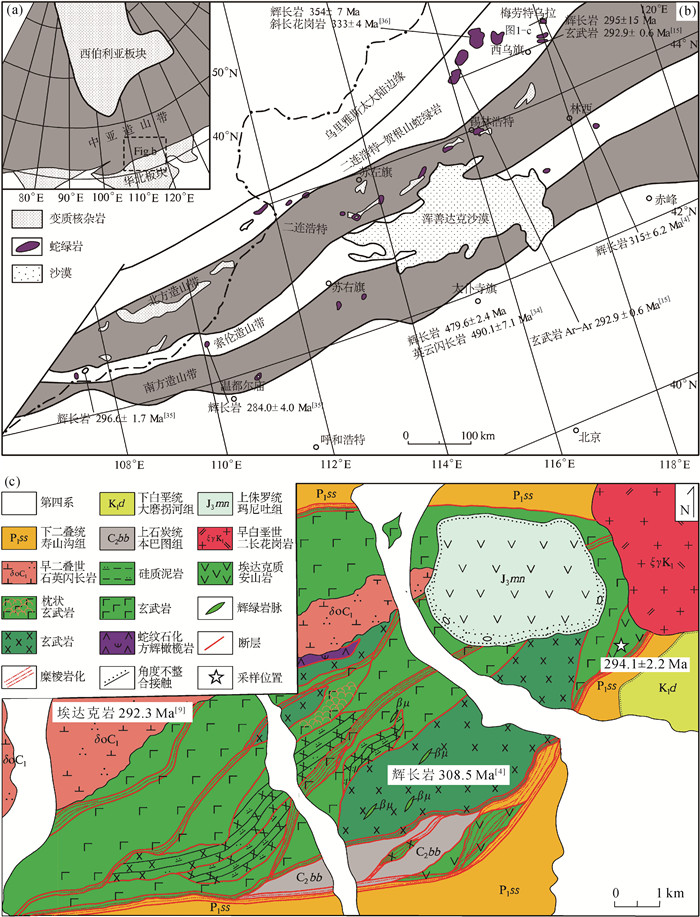
 下载:
下载:


